Creating a zero-waste aesthetic kitchen starts with minimizing waste in food prep and storage. Use reusable containers made of glass or stainless steel to reduce plastic, and embrace composting to cut your kitchen waste by 30%. Opt for bulk buying to limit packaging and plan your meals to avoid over-purchasing. Explore local and seasonal produce for fresher options, saving you money and helping the planet. Incorporating creative meal prep can repurpose leftovers and reduce food waste considerably. If you're ready to transform your kitchen into a stylish zero-waste haven, there's plenty more to discover!
Key Takeaways
- Implement meal planning and creative leftover transformations to significantly reduce food waste and ensure resource utilization in your kitchen.
- Utilize reusable storage solutions like glass jars, stainless steel containers, and beeswax wraps to minimize single-use plastic waste.
- Opt for bulk buying and seasonal produce to cut down on packaging waste and support local economies while ensuring fresher ingredients.
- Adopt eco-friendly materials for kitchen aesthetics, such as bamboo utensils and reclaimed wood shelving, to enhance sustainability and style.
- Start composting organic waste to divert kitchen scraps from landfills and create nutrient-rich soil for gardening, promoting a circular economy.
Definition of a Zero-Waste Kitchen
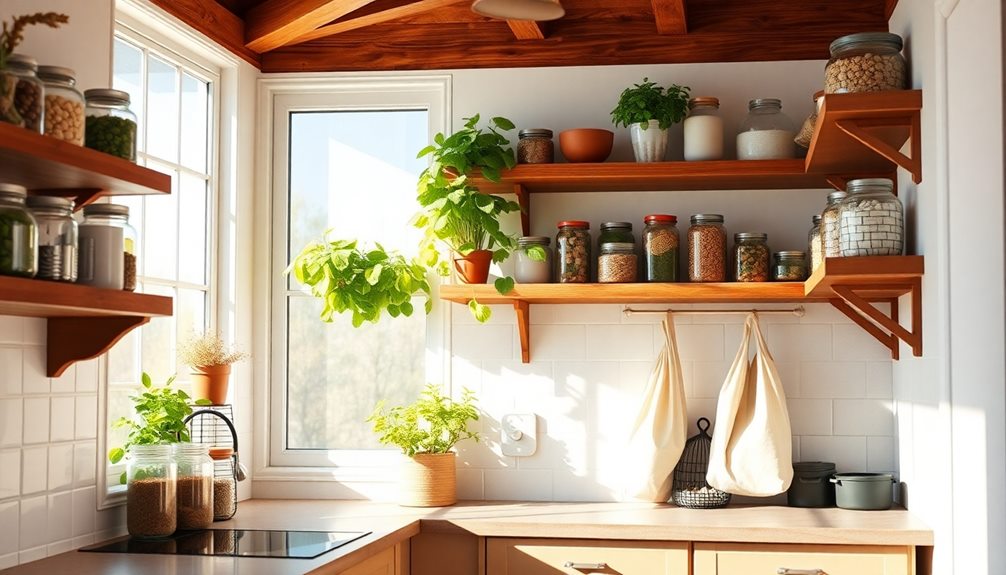
A zero-waste kitchen is all about minimizing waste during food preparation and storage. This approach focuses on reusing, recycling, and composting materials, creating a circular system that maximizes resources and keeps waste to a minimum. By adopting a zero waste kitchen, you can considerably reduce waste and make strides toward sustainable living.
Key principles include using reusable containers and reusable bags for shopping, which can help you avoid single-use plastics. Meal planning is another essential strategy; it allows you to buy only what you need, reducing food waste and ensuring that you utilize everything you purchase.
Embracing bulk buying further cuts down on packaging waste, as you can fill your own containers with just the amount you require. Additionally, composting organic waste plays a crucial role in this lifestyle. Instead of sending food scraps to landfills, you enrich your soil, contributing to a healthier environment.
Benefits of Reducing Food Waste

Reducing food waste not only benefits the environment but also saves you money and resources. By minimizing food waste, you can considerably lower greenhouse gas emissions. When food decomposes in landfills, it produces methane, a potent greenhouse gas that traps heat more effectively than carbon dioxide.
Meal planning and using reusable containers can help you cut down on this waste, potentially saving you around $1,500 annually on groceries—an impressive financial benefit.
Composting food scraps instead of tossing them in the trash also plays an essential role. It reduces the amount of organic waste that ends up in landfills while creating nutrient-rich soil that can enhance your garden's productivity.
Every individual can prevent up to 1,200 pounds of food waste each year through mindful purchasing and consumption habits.
Sustainable Shopping Practices
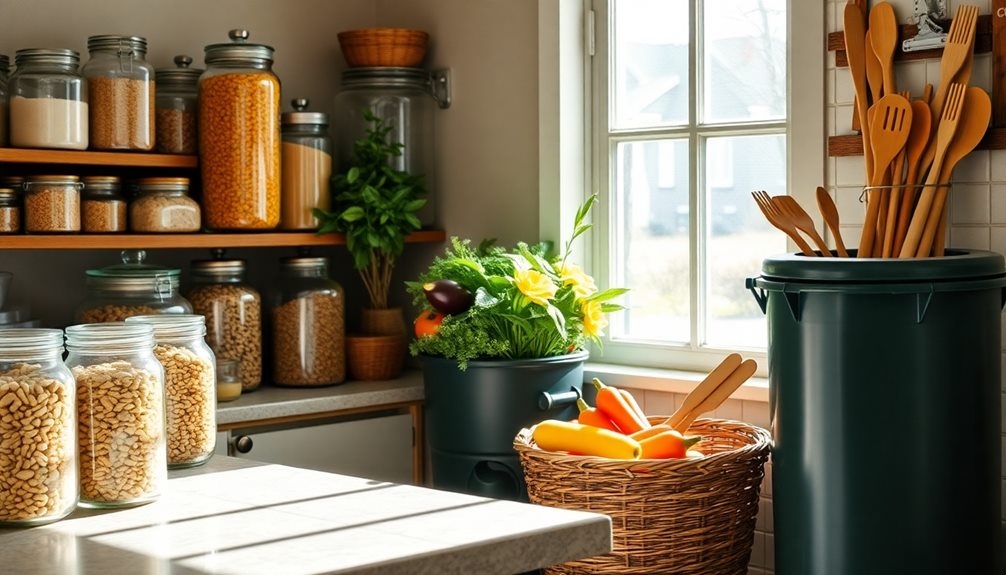
Sustainable shopping practices can notably impact both your wallet and the planet. By embracing bulk buying, you can considerably reduce packaging waste while saving money, as many stores offer discounts on bulk items.
When you bring reusable containers and bags for your shopping trips, you help minimize single-use plastics, which contribute to landfill waste and ocean pollution. Additionally, opting for energy-efficient appliances like heat pumps can further support your commitment to sustainability, as they reduce energy consumption and lower greenhouse gas emissions, contributing to a healthier environment commercial grade heat pumps.
Consider shopping at local farmers' markets. Not only do you support local economies, but you also reduce your carbon footprint by choosing food that hasn't traveled long distances.
Purchasing seasonal produce means you're selecting fresher, tastier options that require less energy to grow and transport, further enhancing your sustainable shopping practices.
Many grocery stores now provide plastic-free options for dry goods, encouraging conscious consumers like you to fill your own containers. This small change can make a big difference in reducing packaging waste.
By integrating these practices into your shopping routine, you not only contribute to a healthier planet but also create a more sustainable kitchen environment.
Creative Meal Preparation Tips
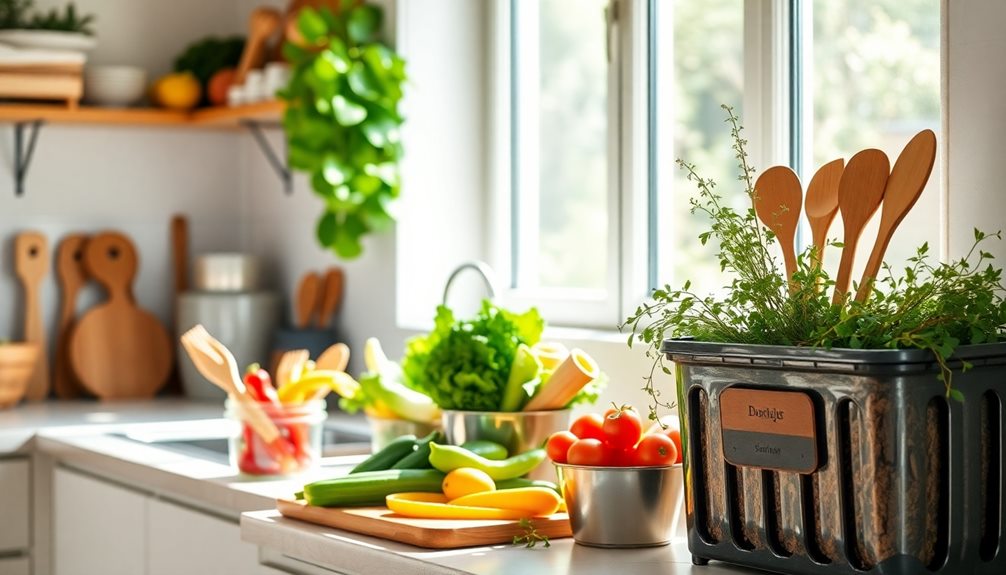
When you plan your meals, focus on using seasonal produce and reducing waste by transforming leftovers into new dishes.
For instance, incorporating ingredients such as tea can enhance flavors while providing health benefits, as tea is rich in antioxidants and may aid in various aspects of health, including heart disease prevention health benefits of tea.
Think about how you can turn vegetable scraps into a flavorful broth or use ripe fruits in smoothies.
With these creative meal prep tips, you'll not only enjoy delicious meals but also nurture a more sustainable kitchen. By incorporating seasonal produce and reducing food waste, you can make your cooking habits more eco-friendly while savoring a variety of fresh flavors. Embrace the allure of al fresco dining by preparing meals that are easy to pack and enjoy outside, whether it’s a picnic in the park or a cozy gathering on your patio. Not only does this elevate the dining experience, but it also encourages a stronger connection with nature.
Meal Planning Essentials
One way to make the most of your groceries and cut down on waste is through effective meal planning. By creating a weekly meal plan, you can take inventory of your pantry and fridge, ensuring you use the ingredients you have on hand. This approach helps you avoid overbuying and reduces food waste by up to 50%.
In divorce proceedings, just as in meal planning, having a clear financial overview, such as a financial affidavit, can help streamline the process and minimize disputes.
Incorporate seasonal produce into your meal plan, as it's fresher, more flavorful, and often less expensive. Preparing meals in bulk is another smart strategy; it saves time and allows you to portion meals into reusable containers, eliminating single-use packaging.
Additionally, consider adding "leftover days" to your meal plan. These days give you the chance to creatively use up excess food, turning potential waste into delicious new dishes.
Leftover Transformation Ideas
Transforming leftovers into new meals can be a fun and creative challenge. You can easily transform leftover vegetables into hearty stir-fries by sautéing them with your favorite sauce, adding flavor while minimizing waste.
If you have stale bread hanging around, don't toss it—repurpose it into breadcrumbs or croutons! These add great texture to salads or can top casseroles, effectively reducing food waste.
For those overripe fruits, blend them into smoothies or use them in baking recipes like muffins and pancakes. This way, you guarantee nothing goes to waste while savoring delicious treats.
Additionally, you can create vegetable stocks by simmering leftover scraps such as onion peels, carrot tops, and celery leaves, resulting in a rich base for soups and sauces.
If you've got leftover meat or proteins, utilize them in casseroles, salads, or wraps. This approach allows for versatile meal options, guaranteeing each ingredient serves a purpose.
Eco-Friendly Storage Solutions

When it comes to eco-friendly storage solutions, you've got plenty of options to choose from.
Reusable containers made of glass or stainless steel not only keep your food fresh but also help you eliminate plastic waste.
Reusable Container Options
Have you ever considered how your food storage choices impact the environment? By opting for reusable containers, you can notably reduce waste and contribute to a more sustainable future.
Glass jars are a fantastic eco-friendly option; they keep your food fresh without leaching harmful chemicals, and you can use them over and over again. Stainless steel containers are another durable choice that minimizes plastic waste, ensuring your food storage is both practical and long-lasting.
For covering food items, try beeswax wraps. They're a healthier alternative to plastic wrap, being reusable and biodegradable.
Additionally, silicone bags offer versatility for freezing, microwaving, and storing, making them an excellent substitute for single-use plastic bags. They're easy to clean and maintain, which makes them a great addition to your kitchen.
Investing in these eco-friendly food storage solutions not only helps you reduce waste but also supports a circular economy. Many of these products are designed to last, and when they reach the end of their life, they can often be repurposed or recycled.
Embrace reusable containers to create a zero-waste aesthetic kitchen that's good for you and the planet!
Sustainable Material Choices
Exploring sustainable material choices for your kitchen storage not only enhances your zero-waste aesthetic but also supports eco-friendly practices.
Start by opting for glass containers or stainless steel storage solutions. These sustainable materials not only avoid chemical leaching from plastics but also improve food preservation. Plus, they're durable and recyclable.
Consider using beeswax wraps as an eco-friendly alternative to plastic wrap. They're reusable for up to a year and compostable at the end of their life cycle.
Silicone bags are another excellent choice; they're reusable, microwave-safe, and help you greatly reduce single-use plastic waste in your kitchen.
When it comes to utensils and organizers, bamboo or cork options are ideal. These biodegradable utensils and organizers are sustainably sourced, minimizing your kitchen's environmental impact.
Additionally, look for storage solutions made from recycled materials, like recycled glass jars and containers, which help support a circular economy.
Creative Storage Ideas
Creating a beautifully organized kitchen is all about leveraging eco-friendly storage solutions that blend functionality with style. Start by using glass jars and containers for pantry items; they prevent chemical leaching and keep your food fresh while enhancing your aesthetic kitchen with their clear design.
Opt for stainless steel or bamboo storage solutions, which are durable and eco-friendly, reducing your reliance on single-use plastics.
To maximize vertical space, implement a tiered shelving system made from reclaimed wood. This not only promotes a clutter-free environment but also adds a rustic charm.
Incorporating reusable produce bags made from organic cotton or mesh for your fruits and vegetables further minimizes plastic waste and adds a natural touch.
Consider stylish, labeled bins or baskets made from sustainable materials to categorize snacks, baking supplies, and utensils.
These creative storage ideas not only keep your kitchen organized but also visually appealing, making it a pleasure to cook and prepare meals.
Embrace these eco-friendly storage solutions to create a zero-waste aesthetic kitchen that reflects your commitment to sustainability while ensuring everything has its place.
Composting for a Greener Kitchen

Composting transforms your kitchen waste into a valuable resource, making it an essential practice for anyone aiming for a greener lifestyle. By composting food scraps like fruit and vegetable peels, coffee grounds, and eggshells, you can divert up to 30% of household waste from landfills. This not only helps reduce waste but also greatly cuts down on methane emissions.
Setting up a compost bin is simple and rewarding. With proper maintenance, including a balance of green (nitrogen-rich) and brown (carbon-rich) materials, moisture, and airflow, you can create nutrient-rich soil in as little as 4-6 weeks. This rich compost enriches your garden beds and potted plants, promoting healthier plant growth and minimizing the need for chemical fertilizers.
Furthermore, composting serves as a sustainable solution to organic waste management. It allows you to contribute to a circular economy by returning valuable nutrients back to the soil. This practice supports local ecosystems and leads to a healthier environment overall.
Plus, it can save your family around $200 each year on waste disposal costs. Embrace composting, and watch as your kitchen waste transforms into a powerful resource!
Alternatives to Single-Use Plastics

Single-use plastics are a considerable environmental concern, contributing to a staggering 300 million tons of plastic waste globally each year. To combat this, you can adopt alternatives to single-use plastics that not only reduce waste but also promote a more sustainable lifestyle.
Start by using reusable produce bags made from cotton or mesh, which can replace those pesky plastic bags during grocery shopping.
Consider investing in beeswax wraps as a sustainable alternative to plastic wrap; they keep your food fresh and are compostable at the end of their lifecycle. For food storage, choose stainless steel or glass containers. These eco-friendly storage containers eliminate the need for plastic, preventing harmful chemicals from leaching into your food.
Additionally, swap out disposable plastic utensils for bamboo alternatives, considerably reducing the estimated 40 billion plastic utensils thrown away annually in the U.S. alone.
Supporting Local and Seasonal Produce
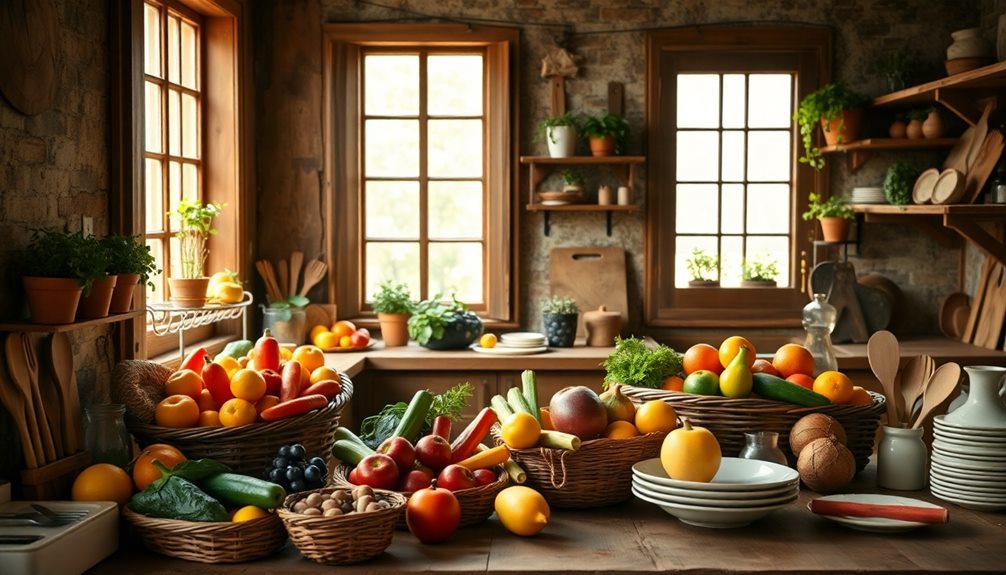
Making sustainable choices in your kitchen goes beyond reducing single-use plastics; it also involves supporting local and seasonal produce. By purchasing local, you reduce carbon emissions considerably, as studies show that local food can cut greenhouse gas emissions by up to 50% compared to imported options. Seasonal produce is often fresher, harvested at its peak, leading to higher nutrient content and better flavor, which enhances your meals.
Engaging with community-supported agriculture (CSA) programs not only supports local farmers but also strengthens your community. About 1 in 4 farmers rely on these programs for their livelihoods. Eating seasonally can save you money, as locally grown produce is typically less expensive when it's abundant. Plus, it helps reduce food waste, aligning perfectly with zero-waste practices.
Here's a quick guide to seasonal produce:
| Season | Fruits | Vegetables |
|---|---|---|
| Spring | Strawberries, Peas | Asparagus, Spinach |
| Summer | Tomatoes, Berries | Zucchini, Peppers |
| Fall | Apples, Pears | Pumpkins, Carrots |
| Winter | Citrus, Persimmons | Kale, Root Vegetables |
| All Year | Apples, Potatoes | Onions, Garlic |
Embrace these choices for a sustainable kitchen!
Embracing a Plant-Based Lifestyle
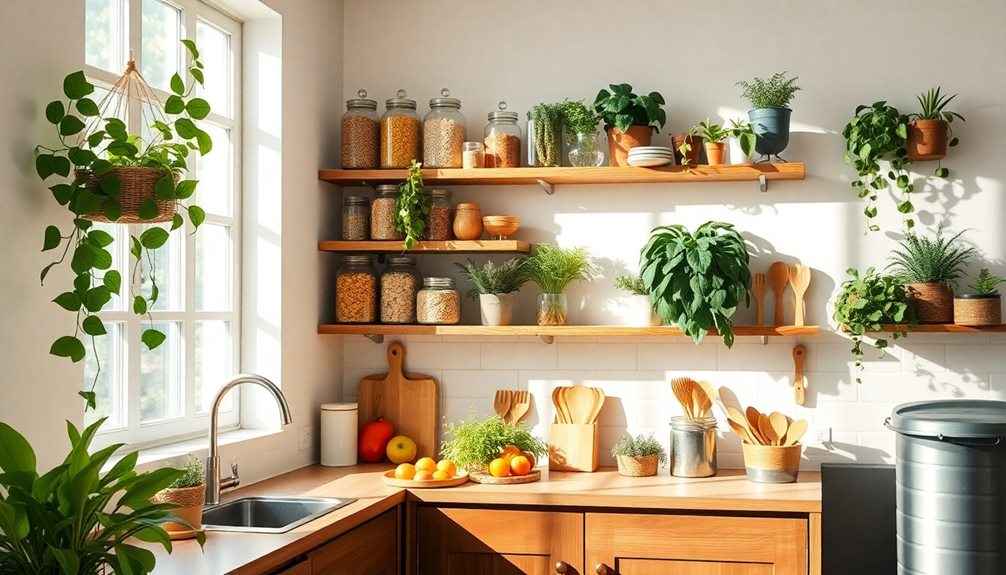
Adopting a plant-based lifestyle can dramatically alter your health and the environment. By shifting to a vegan diet, you can reduce your carbon footprint by up to 50%, as plant-based foods require fewer resources than animal agriculture. This switch not only lowers greenhouse gas emissions but also minimizes water usage—producing one pound of beef needs over 1,800 gallons of water, whereas a pound of vegetables requires just 39 gallons.
Moreover, a plant-based diet is packed with fiber, vitamins, and antioxidants, greatly lowering your risk of chronic diseases like heart disease and type 2 diabetes. It also aligns perfectly with sustainable practices, as fruits and vegetables have a lower spoilage rate compared to meat and dairy, helping you mitigate food waste.
Incorporating these foods into your cooking not only supports your health but also fosters a zero waste kitchen. As you embrace sustainable eating habits, you contribute to a more resilient food system.
The United Nations emphasizes that changing to plant-based diets is essential for achieving climate goals. By doing so, you're playing a significant role in creating a healthier planet.
Frequently Asked Questions
How to Create a Zero Waste Kitchen?
To create a zero waste kitchen, start by auditing your waste, switching to reusable containers, planning meals effectively, composting scraps, and choosing natural cleaning products. You'll reduce waste while promoting a healthier, eco-friendly environment.
How to Build an Eco-Friendly Kitchen?
To build an eco-friendly kitchen, focus on energy-efficient appliances, use reusable containers, and choose sustainable materials. Incorporate natural cleaning products and embrace a minimalist design to create a functional, stylish, and environmentally friendly space.
How Do You Make a Zero Waste Pattern?
To make a zero-waste pattern, you'll want to blend natural materials and colors, utilize reusable containers, incorporate plants for greenery, and choose eco-friendly cleaning supplies, creating a cohesive and sustainable environment that's truly chic.
What Is Zero Waste Cuisine?
Zero waste cuisine emphasizes minimizing food waste by reusing ingredients creatively, composting scraps, and utilizing local produce. You'll enjoy sustainable cooking while contributing to a cleaner environment and developing innovative meals with every dish you prepare.
Conclusion
So, if you're keen on turning your kitchen into a zero-waste wonderland, just remember: it's not about perfection; it's about progress. Sure, you could continue drowning in plastic and food scraps, but why not embrace your inner eco-warrior? After all, who wouldn't want their kitchen to look like a Pinterest board exploded with kale and compost? Let's save the planet one avocado peel at a time—because nothing says "I care" like a chic, waste-free countertop!









